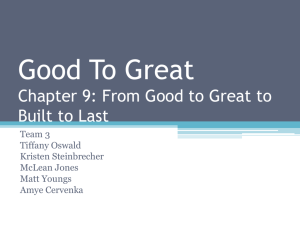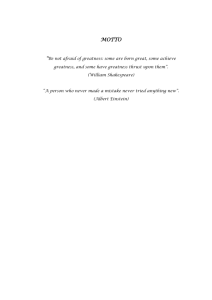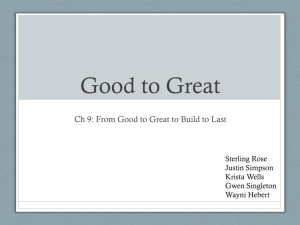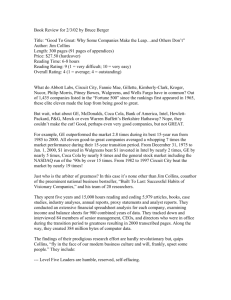Good to Great Chapter 9: *From Good to Great to Built to Last*
advertisement
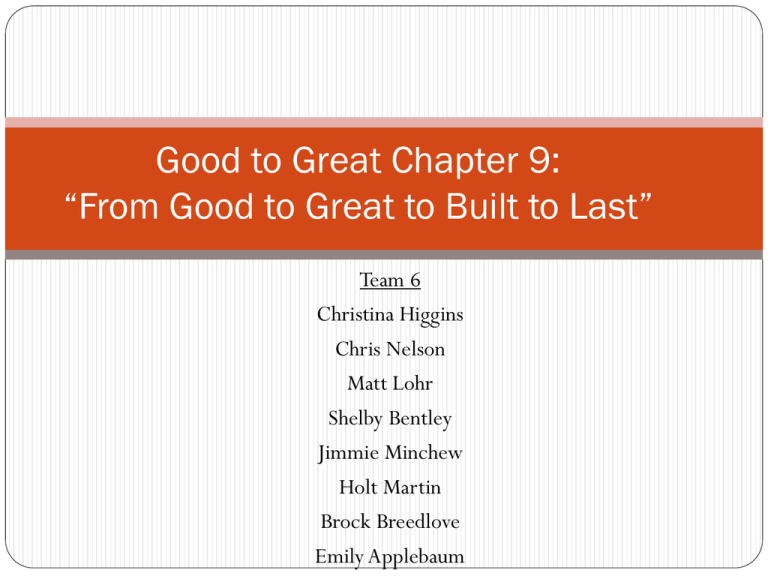
Good to Great Chapter 9: “From Good to Great to Built to Last” Team 6 Christina Higgins Chris Nelson Matt Lohr Shelby Bentley Jimmie Minchew Holt Martin Brock Breedlove Emily Applebaum From Good to Great to Built to Last As we all know by now, the author of Good to Great, Jim Collins, was also a co-author in writing another bestseller Built to Last which was published well before Good to Great. Chapter 9 is the concluding chapter of this book where Jim Collins basically tells his story of how he took the ideology from his previous work and applied it to come up with the ideas to write in Good to Great. Built to Last leads to Good to Great When Jim Collins started to brainstorm for this book, he faced the dilemma of how to make a connection between this book and Built to Last. Built to Last was based on a six-year research project which determined how to build a company from the ground up and whether the company would survive in the long-term. Linkages Between the Books Looking back at the two books, Collins comes up with the following conclusions. All of the leaders in Built to Last actually followed the good-to-great framework Good to Great should ironically actually be viewed as a prequel to Built to Last (a company uses the start-up tools from Good to Great and applies them to make a company Built to Last) A company needs a set of core values in order to achieve the kind of long-term, sustainable success that may lead to greatness. Companies need to exist for a higher purpose than simply profit generation in order to overcome the category of merely good. Good to Great answers the question: what is the difference between a “good” BHAG and a “bad” BHAG? Built to Last does not look to answer this question. From Good to Great to Built to Last First, a company should focus on start-up principles from Good to Great & developing the foundation that is necessary to work toward greatness. Then, they can begin to apply the principles of longevity that are set forth in Built to Last. Early Stages of Good to Great Companies Great companies often do not start out great It took Sam Walton 25 years to grow Wal-Mart from 1 to 38 stores 1970-2000 over 3000 stores and $150 billion in revenues Growth of Home Depot Incorporated in 1978 and went public in 1981 Opened 100th store by 1989 Growth mainly attributed to Bowater Home Centers for $40,000,000 and store acquisitions Entered Canada in 1994, Mexico in 2001 and China in 2006 Now 2,244 stores, 300,000 employees and 25th on Fortune 500 for 2009 Sustainable Growth Great companies take time to grow Good managers look for growth opportunities but do not get in over their head Values are important for companies to grow on help to maintain original vision and not lose focus of core competencies Core Ideology: The Extra Dimension of Enduring Greatness • There is an “extra dimension” for making the transition from good to great to built to last—a “core ideology” that consists of core values and a core purpose (beyond just making money) HP- founder , Bill Hewlett, “proud that he helped create a company that by virtue of its values, practices, and success has had a tremendous impact on the way companies are managed around the world” (the “HP Way”) HP’s core values—technical contribution, respect for individuals, and belief that profit is not the fundamental goal of the company Core Ideology: The Extra Dimension of Enduring Greatness Orange-Blooded: The Home Depot’s Core Values The Home Depot’s values guide the beliefs and actions of all associates on a daily basis. Our values are the fabric of the Company’s unique culture and are central to our success. In fact, they are our competitive advantage in the marketplace. Associate pride and our “orangeblooded” entrepreneurial spirit are distinctive hallmarks of our culture. Core Ideology: The Extra Dimension of Enduring Greatness Enduring great companies don’t exist merely to delivery returns to shareholders. Of course, profits and cash flow become like blood and water to a healthy body: They are absolutely essential for life, but they are not the point of life. Core values are essential for enduing greatness, but it doesn’t seem to matter what those core values are Doesn’t have to: Have passion for its customers (Sony didn’t) Respect for the individual (Disney didn’t) Have quality (Walmart didn’t) Core Ideology: The Extra Dimension of Enduring Greatness • Enduring great companies preserve their core values and purpose while their business strategies and operating practices adapt to a changing world • Ex. Disney Core Ideology: The Extra Dimension of Enduring Greatness Preserve: Change: 1981: HD goes public on NASDAQ 1983: Computerized checkout systems installed 1987: Day-in/Day-out pricing policy established 1991: first EXPO Design Center opens 1995: launches Home Improvement 1-2-3 Books 2000: launches www.homedepot.com Key Ideas: Built to Last Clock Building, Not Time Telling Genius of AND Core Ideology Preserve the Core/Stimulate Progress Conceptual Links Good to Great Built to Last Level 5 Leadership Clock Building, Not Time First Who… Then What Telling Genius of AND Core Ideology Preserve the Core/Stimulate Progress Confront the Brutal Facts Hedgehog Concept Culture of Discipline Technology Accelerators Flywheel, Not Doom Loop Difference between Good BHAGs and Bad BHAGs? Good BHAGs: set with understanding Bad BHAGs: set with bravado What you are deeply passionate about BHAG What you can be the best in the world at What drives your economic engine Boeing and its BHAG Prior focus was military aircraft Stayed away from commercial sphere Applied level 5 leadership and vast experience in jet engines and big planes Became leading commercial aviation company in the world. Home Depot’s Goal “Help consumers create the home of their dreams whether they want to do it themselves or have it done for them.” Home Depot’s current BHAG: Revamping their supply chain Replace warehouse-distribution centers $30 Million dollars per new center Staying Great Adhere to core ideology in the three circles Be willing to change what’s inside the circles though Much easier to become great than to remain great Building Greatness Good VS Great Greatness involves less suffering Add more findings Results in being overworked Waste of energy Cross Country Why Greatness? Doing what you love Not WHY, but HOW? Becoming a Level 5 Leader Home Depot Applying Leadership -Get involved in something you care about -Practice leadership principles at every chance “It is impossible to have a great life unless it is a meaningful life. And it is very difficult to have a meaningful life without meaningful work.” Conclusion • How good to great companies began • Enduring greatness • B-hags “You might even gain that deepest of al satisfactions: knowing that your short time here on earth has been well spent, and that it mattered.”
